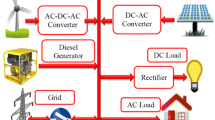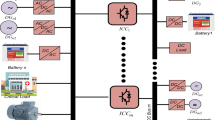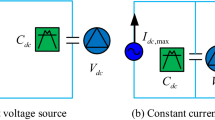Abstract
This paper aims to address the power-sharing requirement and operational reliability of hybrid AC/DC microgrids. Besides, the innovative power management scheme is proposed for interlinking converter by utilizing model predictive control (MPC) strategy to integrate renewable energy sources, energy storage devices, and the utility grid. The proposed control model not only maintains AC and DC bus voltage stable but also ensures the proper power balance between AC and DC sub-microgrids irrespective of the intermittent nature of renewable energy and load fluctuations.
Access provided by Autonomous University of Puebla. Download conference paper PDF
Similar content being viewed by others
Keywords
1 Introduction
Integration of renewable energy sources and storage elements into the power system will enhance the overall system performance. The proliferation of AC/DC microgrids offers higher quality, stability, and reliability with reduced operational cost and power loss to the power system [1]. Regarding AC microgrids, the distributed generators like PV and fuel cells are interconnected to the system that requires DC to AC conversion. To increase the reliability and robustness of the system, the AC microgrid is connected to the utility grid for sharing excess/deficient power. In case of grid failure, all the distributed generators and loads exchange power on the AC platform [2]. Besides, modern power electronic loads operate in DC platforms which require once again AC to DC conversion. In AC microgrid systems, DC-AC-AC-DC conversion is quite common [3]. Conversely, the DC microgrid can facilitate the direct connection of renewables such as PV, fuel cells, and dc loads. However, wind power generators cannot directly be connected to DC microgrids. It requires AC-DC conversion. Besides industrial loads such as induction machines connected to DC microgrids that require once again DC-AC conversion. In DC microgrid systems, AC-DC-DC-AC conversion is inevitable [4, 5]. Therefore, the researchers in recent years have mainly concentrated on the combination of both AC and DC microgrids connected with a common converter called bidirectional interlink converter (ILC) that helps to transfer excess/deficit power from one microgrid to another [6]. This hybrid system can connect along with the utility grid during normal operation. It also gets disconnected from the grid under emergencies and can operate in autonomous mode. This AC/DC hybrid microgrid system avoids multiple conversions which are present in the independent AC or DC microgrid system. However, the control challenges are very severe in hybrid microgrid systems. The primary control objective of AC/DC microgrids is to achieve a power balance between two subgrids [7, 8].
As far as AC/DC microgrid operation is concerned, the control and power management strategies are essential features to determine output powers of distributed generators and control voltage as well as frequency simultaneously [9, 10]. The following challenges are identified when integrating both AC and DC microgrid: In the case of an isolated mode of operation, conventional p-f and q-v droop control methods are not suitable for power-sharing between AC and DC microgrids [11]. Therefore, power management strategy requires a specified droop control method for sharing power demands. In this regard, the interlinking converter plays a vital role in power management and control. Depending on control schemes used in AC and DC microgrids, this ILC can be leveraged on AC bus control mode, DC bus control mode, and power control mode. To equalize the power generation and demand, the bi-directional ILC converter supervises the power flow between DC and AC microgrids under islanding operation conditions [12]. Besides, harmonic power-sharing between the grids is another important challenge in the hybrid system. The tradeoff between voltage regulation and reactive power sharing has gained prominence [13, 14]. The classification of microgrid power control includes centralized control, decentralized control, distributed control, and multi-agent systems. However, these methods of analysis has its own drawbacks. The centralized and decentralized control are combined for the reliable operation of microgrids. This integrated microgrid control strategy is referred to as a hierarchical control structure that has been established for power-sharing among distributed generators [15]. Most of the research so far focuses focus on the droop based hierarchical control with PWM technique. This paper investigates a novel MPC approach for bidirectional ILC control of AC/DC microgrids.
The overview of power management strategies are illustrated in Fig. 1. The main contribution of this work is to develop a power management strategy based on a predictive control approach for interlinking converters in hierarchical controlled hybrid AC/DC microgrid systems. The proposed control scheme can accomplish the optimized power flow between AC as well as DC subgrids. This power management strategy can be performed on AC bus voltage control mode, or dc bus voltage control mode, or bi-directional power control mode. The proposed control design utilizes the model of the microgrid and differs from the existing approaches reported in the literature.
2 Structure of AC/DC Microgrid System
All DC generators and DC loads are connected to the DC bus in the DC microgrid, whereas the AC bus can accommodate all AC generators, AC loads, and utility grids in the AC microgrid. These two subgrids are connected through an interlink converter as shown in Fig. 2. The key benefit of this structure is to minimize the power conversion requirements and improves overall efficiency with reduced system cost.
2.1 DC Bus Voltage Control
Primary control is implemented via a MPC control. Droop control is commonly employed on the primary level of hierarchical control to improve system stability and power-sharing accuracy.
However, voltage deviation takes place. To eliminate the voltage deviation caused by droop control, a voltage secondary control loop is incorporated using MPC approach.
where, \(\delta V_{dc}\) is voltage compensation at secondary control. Integration of distributed energy storage systems in DC microgrids can effectively mitigate the RES and load fluctuations. The charging and discharging operation can be controlled by a bidirectional DC-DC converter under the power mismatch at the DC microgrid.
2.2 AC Bus Voltage Control
To achieve load power sharing between distributed generators for parallel inverter-based ac microgrid system, droop method, as a decentralized control, is generally adopted as,
Using the predicted capacitor voltage, the AC bus voltage can be tracked by controlling the capacitor voltage. Then the cost function generates the least switching sequence applied to the inverter as,
In order to eliminate the voltage deviation caused by droop control, a voltage secondary control loop is incorporated.
Integration of grid into AC microgrids can effectively mitigate the RES and load fluctuations. This can balance the power mismatch at the AC microgrid.
3 Bidirectional Power Flow Control
-
1.
When both the total PV power generation and wind power generation are less than DC as well as AC power demand respectively, all PV sources operate in maximum power point and BILC operates in inverter mode. Then, all BESS supplies the excess total power demand.
-
2.
If the total PV power generation is more than DC power demand, wind power generation is less than AC power demand, and batteries can absorb the surplus power, BILC operates in inverter mode. Then, batteries are charged with excess PV power, and DC microgrid supplies the excess AC power demand.
-
3.
If the total PV power generation is less than DC power demand, wind power generation is more than AC power demand, and batteries can absorb the surplus power, BILC operates in rectifier mode. Then, the AC microgrid not only supplies the excess DC power demand but also charges the batteries.
-
4.
When both the total PV power generation and wind power generation are more than DC as well as AC load power consumption respectively, BILC operates in rectifier mode. Then, all batteries are charged with renewables. Conversely, all batteries are completely charged then a PV power curtailment is performed and switch on the dump loads.
4 Proposed Power Management Strategy
The predictive control scheme for the bi-directional interlink converter is designed coordinately with droop control for the distributed generators in two sub-grids. With the knowledge of power demand with both ac and dc loads \((P_{oad-demand})\), the solar PV power \((P_{pv})\), and the wind power \((P_{wind})\), the total net power is determined as,
This total net power can be balanced through battery/diesel generator using BIL converter. The net power available in the DC bus calculated as,
This net DC power must be balanced through battery energy storage system. Similarly, the net power available in the AC bus calculated as,
This net AC power must be balanced through diesel generator.
By minimizing the objective function yields the optimized control sequence applied to the converter.
5 Simulation Results
Parameters for simulation work:
DC bus voltage: 750 V
PV system: 100 kW, 415 V
WTG: DFIG, 100 kW, 415 V
Battery: lead-Acid 100 kW, 415 V, 2 kAh for 3-Autonomy days
DC variable load: 0–100 kW, 220 V
AC variable load: 0–100 kW, 415 V, 50 Hz
Utility grid: 100 kW, 415 V.
In mode-1: When the generated power from the renewable energy source is more than the load demand, two possible cases are observed from Figs. 3, 4, and 5.
(a) At t = 3 h: If dc load demand is greater than PV power generator and ac load power demand is lesser than wind power generator, the surplus dc power demand is shared with a wind power generator. The excess wind power is charged with batteries. Therefore, BILC act as a rectifier.
(b) At t = 9 h: If dc load demand is lesser than PV power generator and ac load power demand is greater than wind power generator, PV supplies power to both dc as well as ac load. Therefore, BILC works in inverter mode. Excess power generated from solar PV can charge the batteries.
In mode-2: when the generated power from the renewable energy source is less than the load demand, the four possible cases are observed from Figs. 3, 4, and 5.
(a) At t = 1 hrs: If both dc, as well as ac load demand, are more than PV power generator and wind power generator respectively, PV generator operates MPPT mode to supply power to dc load and wind power generator supply power to ac load. However, the excess load power demand (both dc and ac) can be shared by batteries. Therefore, BILC operates in inverter mode.
(b) At t = 2 hrs: If dc load demand is more than PV power generator and ac load power demand is equal to a wind power generator, ac power demand is satisfied with a wind power generator. Both PV and battery are contributed to compensate dc power demand. Therefore, BILC neither operates inverter nor in rectification mode.
(c) At t = 9 hrs: If dc load demand is lesser than PV power generator and ac load power demand is greater than wind power generator, PV supplies power to dc load and the excess ac load demand is shared with both PV and battery system. Therefore, BILC works in inverter mode. Excess power generated from solar PV can be export to the grid.
(d) At t = 22 hrs: If dc load demand is greater than PV power generator and ac load power demand is lesser than wind power generator, the surplus dc power demand is shared with wind power generator as well as a battery bank. Therefore, BILC act as a rectifier. The summary of operational modes of BILC is tabulated in Table 1.
6 Conclusion
An autonomous power flow control approach based on MPC is proposed for a bi-directional interlink converter in this paper. Employing this unique method into hybrid ac/dc subgrids not only manages the power flow but also achieves proper load sharing among distributed generators. Besides, the proposed optimized control strategy prevents circulating current among the ac and the dc microgrids. Moreover, dc and ac bus voltages are precisely regulated and maintain the system stable.
Change history
17 January 2022
Correction to: Chapter “A Unique Interlinking Converter Control for Hybrid AC/DC Islanded Microgrids” in: P. Karrupusamy et al. (eds.), Sustainable Communication Networks and Application, Lecture Notes on Data Engineering and Communications Technologies 93, https://doi.org/10.1007/978-981-16-6605-6_12
References
D. Kumar, F. Zare, A. Ghosh, Dc microgrid technology: system architectures, ac grid interfaces, grounding schemes, power quality, communication networks, applications, and standardizations aspects. IEEE Access 5, 12230–12256 (2017). https://doi.org/10.1109/ACCESS.2017.2705914
S. Jena, N.P. Padhy, Distributed cooperative control for autonomous hybrid ac/dc microgrid clusters interconnected via back-to-back converter control, in 2020 IEEE Power Energy Society General Meeting (PESGM) (2020), pp. 1–5. https://doi.org/10.1109/PESGM41954.2020.9281505
H. Abu-Rub, M. Malinowski, K. Al-Haddad, AC-DC-AC Converters for Distributed Power Generation Systems (2014), pp. 319–364. https://doi.org/10.1002/9781118755525.ch11
F. Nejabatkhah, Y.W. Li, Overview of power management strategies of hybrid ac/dc microgrid. IEEE Trans. Power Electronics 30(12), 7072–7089 (2015). https://doi.org/10.1109/TPEL.2014.2384999
J. Wang, C. Jin, P. Wang, A uniform control strategy for the interlinking converter in hierarchical controlled hybrid ac/dc microgrids. IEEE Trans. Industrial Electronics 65(8), 6188–6197 (2018). https://doi.org/10.1109/TIE.2017.2784349
X. Shen, D. Tan, Z. Shuai, A. Luo, Control techniques for bidirectional interlinking converters in hybrid microgrids: leveraging the advantages of both ac and dc. IEEE Power Electronics Mag. 6(3), 39–47 (2019). https://doi.org/10.1109/MPEL.2019.2925298
S. Peyghami, H. Mokhtari, F. Blaabjerg, Autonomous operation of a hybrid ac/dc microgrid with multiple interlinking converters. IEEE Trans. Smart Grid 9(6), 6480–6488 (2018). https://doi.org/10.1109/TSG.2017.2713941
P. Lin, P. Wang, C. Jin, J. Xiao, X. Li, F. Guo, C. Zhang, A distributed power management strategy for multi-paralleled bidirectional interlinking converters in hybrid ac/dc microgrids. IEEE Trans. Smart Grid 10(5), 5696–5711 (2019). https://doi.org/10.1109/TSG.2018.2890420
G.D. Agundis Tinajero, M. Nasir, J.C. Vasquez, J.M. Guerrero, Comprehensive power flow modelling of hierarchically controlled ac/dc hybrid islanded microgrids. Int. J. Electrical Power Energy Syst. 127, 106629 (2021)
V. Bindhu, G. Ranganathan, Effective automatic fault detection in transmission lines by hybrid model of authorization and distance calculation through impedance variation. J. Electronics Informatics 3(1), 36–48 (2021). https://doi.org/10.36548/jei.2021.1.004
J. Hofer, B. Svetozarevic, A. Schlueter, Hybrid ac/dc building microgrid for solar pv and battery storage integration, in 2017 IEEE Second International Conference on DC Microgrids (ICDCM) (2017), pp. 188–191. https://doi.org/10.1109/ICDCM.2017.8001042
T. Vijayakumar, R. Vinothkanna, Efficient energy load distribution model using modified particle swarm optimization algorithm. J. Artif. Intelligence Capsule Netw. 2(4), 226–231 (2020). https://doi.org/10.36548/jaicn.2020.4.005
F. Nejabatkhah, Y.W. Li, H. Tian, Power quality control of smart hybrid ac/dc microgrids: an overview. IEEE Access 7, 52295–52318 (2019). https://doi.org/10.1109/ACCESS.2019.2912376
N. Bhalaji, C. Rimi, Remaining useful life (rul) estimation of lead acid battery using Bayesian approach. J. Electrical Eng. Autom. 2(1), 25–34 (2020). https://doi.org/10.36548/jeea.2020.1.003
M. Najafzadeh, R. Ahmadiahangar, O. Husev, I. Roasto, T. Jalakas, A. Blinov, Recent contributions, future prospects and limitations of interlinking converter control in hybrid ac/dc microgrids. IEEE Access 9, 7960–7984 (2021). https://doi.org/10.1109/ACCESS.2020.3049023
Author information
Authors and Affiliations
Corresponding author
Editor information
Editors and Affiliations
Rights and permissions
Copyright information
© 2022 The Author(s), under exclusive license to Springer Nature Singapore Pte Ltd.
About this paper
Cite this paper
Jayachandran, M., Rao, G.S., Reddy, C.R. (2022). A Unique Interlinking Converter Control for Hybrid AC/DC Islanded Microgrids. In: Karrupusamy, P., Balas, V.E., Shi, Y. (eds) Sustainable Communication Networks and Application. Lecture Notes on Data Engineering and Communications Technologies, vol 93. Springer, Singapore. https://doi.org/10.1007/978-981-16-6605-6_12
Download citation
DOI: https://doi.org/10.1007/978-981-16-6605-6_12
Published:
Publisher Name: Springer, Singapore
Print ISBN: 978-981-16-6604-9
Online ISBN: 978-981-16-6605-6
eBook Packages: EngineeringEngineering (R0)









